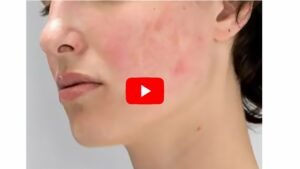1. What Are the Benefits of Omega-3 Fatty Acids for Your Skin?
You must obtain omega-3 fatty acids from your diet or supplements because your body is unable to create them on its own. The three most well-known forms are ALA (alpha-linolenic acid), which is derived from plant-based sources like flaxseeds and walnuts, DHA (docosahexaenoic acid), and EPA (eicosapentaenoic acid), which are both present in oily fish. Although omega-3 fatty acids are most well-known for promoting heart and brain health, their advantages for acne and skin health are also receiving a lot of attention.
Omega-3 fatty acids function in the background to soothe your skin from the inside out when it comes to acne, particularly hormonal or inflammatory acne. Being potent anti-inflammatories, these fatty acids aid in lowering the redness, swelling, and soreness that are frequently connected to breakouts. Omega-3 fatty acids help prevent acne before it starts by reducing levels of inflammatory chemicals like prostaglandins and cytokines. This is important since rosacea and cystic acne are among the many skin conditions that are primarily caused by inflammation.
In particular, androgens like testosterone, which can cause oil production and clogged pores, are regulated by omega-3 fatty acids. For women, a consistent intake of omega-3 fatty acids may help control breakouts, particularly during menstruation or hormonal changes. Furthermore, by keeping the skin barrier hydrated and strong, these fatty acids help to heal acne that has already occurred and stop flare-ups in the future.
To put it briefly, omega-3 fatty acids are a skin-saving ingredient that tackles acne at its source, making them more than just a trendy wellness supplement. Your skin will appreciate them whether you incorporate them through chia seeds, wild-caught salmon, or a premium fish oil supplement.
2. The Science of Omega-3s and Inflammation in Acne
Inflammation is at the core of most acne, particularly the painful, red, and swollen type. Hormonal imbalances, stress, poor diet, and environmental variables are frequently the causes of an inflammatory response. Your skin may react with clogged pores, excessive oil production, and those dreaded deep pimples when your body creates too many pro-inflammatory chemicals, such as cytokines and leukotrienes. This is where the natural anti-inflammatory properties of omega-3 fatty acids, especially EPA and DHA, come into play.
Fish like salmon, mackerel, and sardines contain EPA, which helps lower the production of inflammatory molecules and encourages the formation of anti-inflammatory compounds called protectins and resolvins. These substances lessen the intensity and frequency of breakouts by calming the skin’s reactivity to the immune system. Higher blood levels of EPA have been associated with a reduction in acne lesions and skin redness, according to research.
Additionally, omega-3s aid in controlling the production of oil on the skin. They lessen the likelihood of clogged pores, a major cause of acne, by regulating sebum production. Furthermore, by promoting insulin sensitivity and lowering stress hormones like cortisol, which are both connected to flare-ups of acne, omega-3 fatty acids may indirectly affect hormone levels. Their influence is therefore profoundly systemic rather than merely surface-level.
The theory is simple: omega-3 fatty acids work at the root of acne by reducing inflammation, regulating oil production, and resolving hormonal imbalances. Adding more omega-3s to your diet or supplement regimen could be a game-changer if you’re dealing with dry, irritated skin.
3. Finding the Correct Balance for Clear Skin with Omega-3s vs. Omega-6s
Not only is it important to consume adequate omega-3 fatty acids for healthy skin, but it’s also important to balance them with omega-6 fatty acids. Your body requires both omega-3 and omega-6 fats for a number of processes, such as hormone synthesis and cell structure. However, when taken in excess, omega-6s tend to exacerbate inflammation, whereas omega-3s are well-known for their anti-inflammatory qualities. This equilibrium between the two is essential for managing acne and skin inflammation.
Omega-6 fatty acids, which are present in processed and fried foods and many vegetable oils like corn, soybean, and sunflower oils, are frequently abundant in modern diets. The body creates more pro-inflammatory chemicals when omega-6 intake greatly exceeds omega-3 intake. This can exacerbate acne symptoms by raising sebum production, redness, and swelling. This imbalance may worsen hormonal acne flare-ups and interfere with the skin’s natural healing process.
Experts advise striving for a more balanced ratio of omega-3 to omega-6, ideally between 1:1 and 1:4, to support smoother skin. This entails reducing your consumption of processed foods and omega-6-rich oils while increasing your intake of foods high in omega-3, such as walnuts, chia seeds, flaxseeds, and fatty fish. You can lessen systemic inflammation and promote the healing and clarity of your skin by reestablishing this equilibrium.
Essentially, establishing the ideal balance between these vital fats is more important for acne treatment than simply increasing omega-3 intake. You’ll notice reduced redness, fewer breakouts, and healthier, more resilient skin when your body finds the balance it requires.

✅ Struggling with acne? Discover the 2 natural solutions I personally recommend 👉CLICK HERE
4. Top Sources of Omega-3 to Combat Acne
Selecting the appropriate sources is crucial when trying to increase your omega-3 intake to combat acne. Fatty fish like salmon, mackerel, sardines, and anchovies are the main source of the most powerful forms of omega-3s, EPA and DHA. Because of their high bioavailability, your body can effectively absorb and utilize these marine-based omega-3s to maintain healthy skin and lessen inflammation. Including these fish in your diet on a regular basis can give your acne-prone skin a strong, natural boost.
The omega-3 form of ALA (alpha-linolenic acid), which is present in flaxseeds, chia seeds, walnuts, and hemp seeds, is suitable for people who prefer plant-based foods or who wish to supplement their fish intake. These foods nevertheless include important nutrients and fiber that support general skin wellness, even though the body must convert ALA into EPA and DHA (a process that isn’t very effective). A well-rounded omega-3 profile can be achieved by consuming fatty fish together with a range of various plant sources.
High-quality omega-3 supplements such as fish oil, krill oil, or algae oil (a fantastic vegan substitute) can help bridge the gap if obtaining adequate omega-3s from food seems difficult. The reason algae oil is so intriguing is that, like fish oil, it provides EPA and DHA directly without the need for animal sources. For optimal skin benefits, choose supplements with a high concentration of EPA and DHA and those that have been processed to eliminate heavy metals.
The greatest omega-3 sources for acne treatment are ultimately those that complement your diet and lifestyle and offer steady, anti-inflammatory support for healthier, clearer skin. Omega-3s can revolutionize your acne treatment regimen, whether you take them as dependable supplements or in the form of delectable meals.
5. How Much Omega-3 Is Appropriate for Treating Acne?
The severity of your acne, your present diet, and your general health all play a role in figuring out how much omega-3 fatty acids you should take to treat it. Although there isn’t a single, universally applicable dosage, the majority of research indicates that consuming 1,000–2,000 mg of EPA and DHA daily can effectively reduce inflammation and improve skin clarity. A combination of dietary sources and supplements can help adults reach this amount, which is generally safe.
Since the contents of many fish oil capsules vary greatly, it’s crucial to read the label to determine the precise amounts of EPA and DHA if you’re depending on supplements. Since EPA is especially effective at lowering inflammation linked to acne, look for a supplement that contains at least 500 mg of EPA. Higher dosages, up to 3,000 mg per day, may provide extra advantages, according to some research, but they should be taken under a doctor’s care to prevent negative effects like blood thinning or stomach pain.
In order to enhance absorption and lower the possibility of moderate side effects like nausea or fishy burps, it’s also a good idea to space out your omega-3 intake throughout the day rather than taking a big amount all at once. To ensure safety, speak with your doctor before beginning omega-3 supplements if you are pregnant, nursing, or on blood thinners.
In the end, when using omega-3s to treat acne, consistency is crucial. After taking supplements on a regular basis for 6 to 12 weeks, you can notice improvements in skin texture, less redness, and fewer breakouts. You can increase your chances of having healthier, clearer skin by combining omega-3 intake with a healthy diet and regular skincare routine.
6. Expected Outcomes: How Omega-3s Enhance Skin Over Time
It’s crucial to have reasonable expectations regarding the timeframe for results when you begin using omega-3 fatty acids in your acne treatment regimen. The benefits of omega-3s are often gradual rather than instantaneous since they function by lowering inflammation and restoring hormone balance from the inside out. After taking supplements consistently for four to six weeks, many people usually start to notice minor changes in skin texture and decreased redness.
Omega-3 fatty acids can dramatically reduce the frequency and intensity of acne flare-ups by the 8–12 week point, particularly for inflammatory lesions like cysts and pustules. The anti-inflammatory qualities aid in calming your skin’s immune system, which lessens breakouts now and hastens the healing process. Omega-3 fatty acids also strengthen the skin barrier, improving resilience and moisture retention, all of which lead to a healthier, more radiant complexion.
It’s also important to remember that omega-3s work best when paired with other acne-fighting techniques including a healthy diet, good skincare, and lifestyle adjustments like stress reduction and getting enough sleep. They are a potent tool that enhances your whole skin care regimen rather than a miracle remedy. Unlocking these long-term advantages requires constant adherence to your omega-3 program.
In conclusion, omega-3 fatty acids target the underlying causes of inflammation and hormonal imbalance, but they won’t instantly eradicate acne. Over time, you can anticipate calmer, clearer skin and fewer breakouts if you are persistent and patient.
✅ Struggling with acne? Discover the 2 natural solutions I personally recommend 👉CLICK HERE








The text embodies a layered subtlety, where intellectual clarity and emotional resonance coexist, encouraging the reader to linger, observe, and uncover meaning gradually with attentive engagement and thoughtful reflection.
thank-you